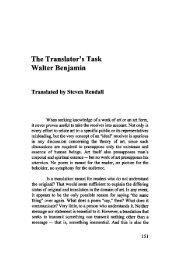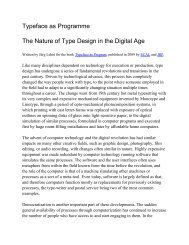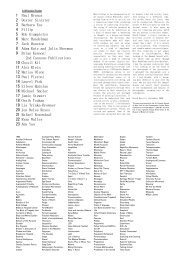Konstnären och kulturnäringarna Artists and the Arts Industries
Konstnären och kulturnäringarna Artists and the Arts Industries
Konstnären och kulturnäringarna Artists and the Arts Industries
Create successful ePaper yourself
Turn your PDF publications into a flip-book with our unique Google optimized e-Paper software.
Yudhishthir Raj Isar<br />
<strong>Artists</strong> <strong>and</strong> <strong>the</strong> Creative <strong>Industries</strong>:<br />
Problems with <strong>the</strong> Paradigm<br />
Introduction<br />
When any paradigm becomes as dominant in cultural discourse<br />
as <strong>the</strong> notion of ‘cultural <strong>and</strong> creative industries’, it needs to be<br />
unpacked, questioned <strong>and</strong> challenged. This one could be critiqued<br />
from many different perspectives. From that of <strong>the</strong> individual<br />
artist, for example, one might ask exactly how she might benefit<br />
from having her work framed in ‘creative industries’ terms. 13<br />
Does such a framing represent progress for <strong>the</strong> artist? And if so,<br />
how should he/she respond in order to benefit as richly as possible<br />
from this progress? Such questions become even more relevant<br />
in <strong>the</strong> context of <strong>the</strong> reflection process set in motion by <strong>the</strong> Swedish<br />
<strong>Arts</strong> Grants Committee on topics raised in <strong>the</strong> <strong>the</strong> Swedish<br />
government’s action plan for <strong>the</strong> cultural <strong>and</strong> creative industries.<br />
The questions posed by <strong>the</strong> Committee are ones that artists <strong>and</strong><br />
13 I shall henceforth use <strong>the</strong> more capacious term – ‘ creative industries’ –<br />
simply because it has become <strong>the</strong> more greatly favoured catchword of <strong>the</strong> two.<br />
I myself prefer <strong>the</strong> earlier term ‘cultural industries’, which is more closely<br />
related to <strong>the</strong> remit of artistic practice.<br />
<strong>the</strong>ir well-wishers are asking in many settings across <strong>the</strong> world.<br />
In <strong>the</strong> context of this ambitious undertaking, my brief was to<br />
provide a global perspective on how <strong>the</strong> artist figures in this economistic<br />
framing. On a worldwide canvas, what is <strong>the</strong> mutual<br />
benefit? Is it a win-win situation? How does <strong>the</strong> work of individual<br />
artists contribute to <strong>the</strong> way <strong>the</strong> creative industries are<br />
developing? Does <strong>the</strong> flourishing of <strong>the</strong> latter improve <strong>the</strong> lot of<br />
<strong>the</strong> artist?<br />
Now, before I even set to work on this brief, I could not avoid<br />
challenging <strong>the</strong> assumption that it is right <strong>and</strong> proper to accord<br />
such uncontested primacy to <strong>the</strong> economic calculus as <strong>the</strong> central<br />
policy issue. Is <strong>the</strong> discursive hegemony acceptable? As <strong>the</strong><br />
discourse has evolved from <strong>the</strong> ‘cultural industries’ to <strong>the</strong> ‘creative<br />
industries’ <strong>and</strong> subsequently to an even broader category,<br />
<strong>the</strong> ‘creative economy’, all <strong>the</strong>se terms have become <strong>the</strong> banner<br />
heads of a b<strong>and</strong>wagon that many ride for fear of being left behind,<br />
without realizing that as cultural actors <strong>the</strong>y are increasingly be-<br />
coming both instrumentalizing <strong>and</strong> instrumentalized. We know<br />
that <strong>the</strong> language of business has formatted ways of thinking <strong>and</strong><br />
seeing in many different arenas, <strong>and</strong> that both ‘enterprise’ <strong>and</strong><br />
‘entrepreneurship’ have become positively charged keywords. But<br />
should market <strong>and</strong> ‘management’ criteria be allowed to lead unchallenged?<br />
Who would quarrel with <strong>the</strong> notion that artists <strong>and</strong><br />
<strong>the</strong>ir organizations ought to operate efficiently <strong>and</strong> effectively?<br />
Yet, are <strong>the</strong> nature, extent <strong>and</strong> efficiency of <strong>the</strong>ir contributions to<br />
<strong>the</strong> economy <strong>the</strong> only values that <strong>the</strong> policy maker should choose<br />
to value? Is this <strong>the</strong> only arena in which <strong>the</strong>y can deliver ‘value<br />
for money’? Aren’t <strong>the</strong>re o<strong>the</strong>r issues that are just as central to<br />
<strong>the</strong> condition <strong>and</strong> contribution of <strong>the</strong> artist? Their place <strong>and</strong> role<br />
in a healthy democratic polity, for example. So <strong>the</strong> argument I<br />
am making here, even as I address <strong>the</strong> brief I was given, is that<br />
we ought to if not change <strong>the</strong>n at least broaden <strong>and</strong> diversify <strong>the</strong><br />
brief itself. There is a real need to shift <strong>the</strong> terms of <strong>the</strong> debate<br />
away from <strong>the</strong> economic alone, <strong>and</strong> for this reason it behoves us<br />
to determine o<strong>the</strong>r terms of engagement.<br />
I shall return to this point of view briefly later, but before doing<br />
so I should like to comment also on <strong>the</strong> way in which <strong>the</strong> very<br />
notion of ‘creativity’ has been comm<strong>and</strong>eered by <strong>the</strong> creative<br />
industries discourse. In <strong>the</strong> process, creativity has ceased to be<br />
<strong>the</strong> privileged capacity of art <strong>and</strong> artists. Instead, <strong>the</strong> creative<br />
industries discourse has pushed artistic practice to <strong>the</strong> sidelines<br />
Yudhishthir Raj Isar | Problems with <strong>the</strong> Paradigm<br />
– despite <strong>the</strong> continuing veneration of <strong>the</strong> artist as demiurge<br />
<strong>and</strong> <strong>the</strong> mystique attached to singular, individual artistic genius.<br />
Also, <strong>the</strong> creative industries logic misses out on some of <strong>the</strong> most<br />
important features of <strong>the</strong> contemporary dynamics of creativity<br />
<strong>and</strong> innovation in arts practice as marked by globalization. The<br />
anthropologist Maruška Svašek, for example, foregrounds four<br />
key notions: ‘transit’, ‘transition’, ‘transformation’ <strong>and</strong> ‘improvisation’<br />
(Svašek, 2010). Transit refers to <strong>the</strong> trans-local <strong>and</strong><br />
trans-national movements of people, objects <strong>and</strong> images across<br />
space <strong>and</strong> time that mark our ep<strong>och</strong>; transition to transit-related<br />
changes of meaning, value, <strong>and</strong> emotional efficacy of objects <strong>and</strong><br />
images; transformation to <strong>the</strong> dynamic ways in which artists <strong>and</strong><br />
o<strong>the</strong>r cultural producers relate to <strong>the</strong> changing social <strong>and</strong> material<br />
environments <strong>the</strong>y find <strong>the</strong>mselves in. Finally, improvisation<br />
relates to how such actors react to new challenges <strong>and</strong> dem<strong>and</strong>s<br />
by taking on contextually specific roles <strong>and</strong> identities <strong>and</strong> by<br />
gaining various degrees of ownership over creative processes <strong>and</strong><br />
<strong>the</strong>ir outcomes. I would contend that <strong>the</strong>se processes <strong>and</strong> <strong>the</strong><br />
issues <strong>the</strong>y generate are more germane to <strong>the</strong> condition of <strong>the</strong><br />
artist today than <strong>the</strong> creative industries discourse can ever be.<br />
This was precisely why <strong>the</strong> third volume in <strong>the</strong> book series<br />
I co-edit was devoted to <strong>the</strong> topic Cultural Expression, Creativity<br />
<strong>and</strong> Innovation <strong>and</strong> included <strong>the</strong> reflections of Svašek <strong>and</strong><br />
o<strong>the</strong>rs who think along such lines. The goal was to explore <strong>the</strong><br />
interactions between globalization <strong>and</strong> individual artistic practice,<br />
not just between globalization <strong>and</strong> <strong>the</strong> mass-scale, increasingly<br />
digitalized, production, distribution <strong>and</strong> consumption of<br />
cultural goods <strong>and</strong> services. In <strong>the</strong> same volume, we asked <strong>the</strong><br />
Indian <strong>the</strong>atre scholar <strong>and</strong> arts commentator Rustom Bharucha,<br />
28 29









